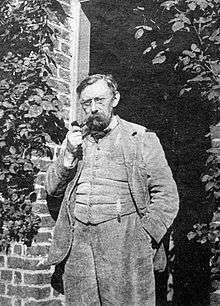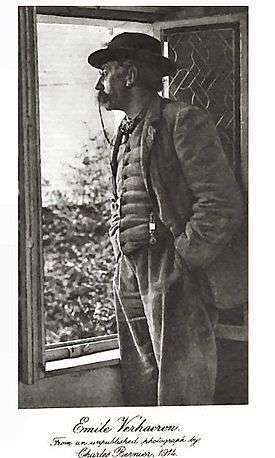Émile Verhaeren
| Émile Verhaeren | |
|---|---|
 Portrait of Verhaeren by Théo van Rysselberghe | |
| Born |
May 21, 1855 Sint-Amands, Belgium |
| Died |
November 27, 1916 (aged 61) Rouen, France |
| Occupation | Poet, writer, art critic |
| Signature | |
 | |

Émile Adolphe Gustave Verhaeren (Dutch: [vərˈɦaːrən]; 21 May 1855 – 27 November 1916) was a Belgian poet who wrote in the French language and an art critic. He was one of the founders of the school of Symbolism and was nominated for the Nobel Prize in Literature on six occasions.[1]
Early life
Émile Verhaeren was born into a middle-class family in Sint-Amands, a rural commune in Belgium's Province of Antwerp. In addition to the local Dutch dialect, he adopted French as his language of culture, as was common for Belgian elites at the time. At the age of eleven, he was sent to a strict boarding school in Ghent run by Jesuits, the Jesuit College of Sainte Barbe, where he formed a friendship with Georges Rodenbach[2]. He then went to study law at the University of Leuven, where he produced his first literary efforts in a student paper, La Semaine, which he edited in conjunction with the operatic singer Ernest van Dyck. La Semaine was suppressed by the authorities, as was its successor, Le Type, in which Verhaeren had as fellow-workers Max Waller, Iwan Gilkin and Albert Giraud.[2] His like-minded acquaintances later became his collaborators on the revolutionary artistic magazine La Jeune Belgique.
Having gained his law degree, he became a trainee (1881–1884) with Edmond Picard, a renowned criminal lawyer and influential figure within Brussels' artistic scene. Verhaeren came in frequent contact with young, radical writers and artists at a time of artistic renewal. He tried only two cases in a courtroom before deciding to dedicate his life to poetry and literature.
Art criticism
He soon became the spokesperson for the artistic revival at the turn of the century. Fascinated by the works of the painters of the artistic circle "Les XX", he wrote many articles in La Jeune Belgique and L'Art Moderne with flamboyant criticism on the artistic-literary works of the Brussels art world. He made himself especially the champion of the impressionist painters,[2] and his articles brought many promising young talents, such as James Ensor, to the attention of the public.
Through these articles, he became a lifelong friend of the Neo-impressionist Belgian painter Théo van Rysselberghe, resulting in a vast body of letters. In one of these letters, he was described by Maria van Rysselberghe, as "a unique personality, a whirlwind with an indomitable character, who didn't bother himself about bourgeois rules and who provoked or overwhelmed everybody by his straightforward directness".
Literature
He was one of the most prolific poets of his era. His first collection of poems, Les Flamandes, was published in 1883. Inspired by the paintings of Jacob Jordaens, David Teniers and Jan Steen, Verhaeren described in a direct and often provocative, naturalistic way his country and the Flemish people. It was an immediate success in avant-garde milieus, but caused a great deal of controversy in Catholic circles. His next book, Les Moines (1886), was not the success he had hoped for. This, and his health problems, led to a deep crisis. In this period he published Les Soirs (1888), Les Débâcles (1888) and Les Flambeaux noirs (1891).
On 24 August 1891 he married Marthe Massin, a talented artist from Liège. His new-found happiness found expression in three poetry books: Les Heures Claires (1896), Les Heures d'Après-midi (1905) and Les Heures du Soir (1911). His later poems include Les Rythmes souverains (1910), Les Villes à pignons (1910), Les Plaines (1911) and Les Blés Mouvants (1912).[3]

He wrote his first play, Les Aubes, in 1898. Here he waged a fight against social injustice and the decline of life in the countryside. In 1912, he produced a tragedy, Hélène de Sparte, which was performed in German and Russian, besides French.[3]
In 1898 he moved to Saint-Cloud, near Paris. By the turn of the century, he had become world-famous. His works were translated into more than twenty languages. His German translator was Stefan Zweig.[4][5] He travelled, giving lectures, throughout Europe.
The outbreak of World War I had a devastating effect on the poet's deep pacifist feelings. He went to England, where he received honorary degrees from various universities. During his exile, he published Les Ailes rouges de la Guerre.[3]
Death
Émile Verhaeren died on 27 November 1916 at Rouen station: he fell under a moving train while trying to board it.[3] Marthe Verhaeren was informed of the death of her husband by Théo van Rysselberghe and his friend, the famous French writer (and later Nobel Prize winner) André Gide.
Verhaeren's vast body of work supports claims that he is one of the most prominent figures in Belgian literature. He narrowly missed the Nobel Prize for Literature in 1911; it was instead awarded to his friend, Maurice Maeterlinck.
St. Amands, his native city, has dedicated a museum to this giant of Belgian literature, showing many original manuscripts of his works and letters along with works of his artistic friends Théo van Rysselberghe, Léon Spilliaert, Constantin Meunier, Paul Signac and Ossip Zadkine.
Honours
- 1920: Post mortem Grand Cordon of the Order of Leopold.[6]
Principal works
- Les Flamandes, 1883
- Les moines, 1886
- Les soirs, 1888
- Les débâcles, 1888
- Les flambeaux noirs, 1891
- Les campagnes hallucinées, 1893
- Les villes tentaculaires, 1895
- Les heures claires, 1896
- Les visages de la vie, 1899
- Les forces tumultueuses, 1902
- La multiple splendeur, 1906
- Les rythmes souverains, 1910
- Les ailes rouges de la guerre, 1916
- Les flammes hautes, 1917 [written in 1914]
References
- ↑ "Nomination Database". www.nobelprize.org. Retrieved 2017-04-19.
- 1 2 3

- 1 2 3 4

- ↑ S. Zweig, Die Welt von Gestern
- ↑ Stefan Zweig: Rembrandt, Insel Verlag, Leipzig 1923
- ↑ RD 12.01.1920
External links
| Wikimedia Commons has media related to Émile Verhaeren. |
- Works by Emile Verhaeren at Project Gutenberg
- Works by or about Émile Verhaeren at Internet Archive
- Works by Émile Verhaeren at LibriVox (public domain audiobooks)

- Selected poems by Verhaeren (in French)
- Les campagnes hallucinées, 1893
- Newspaper clippings about Émile Verhaeren in the 20th Century Press Archives of the German National Library of Economics (ZBW)